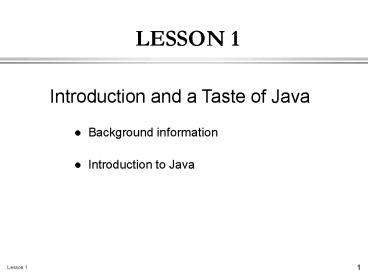Background information - PowerPoint PPT Presentation
1 / 17
Title: Background information
1
LESSON 1
Introduction and a Taste of Java
- Background information
- Introduction to Java
2
Object-Oriented Concepts
- What is an Object?
- A software bundle of related variable methods.
Often used to model real-world objects. - What is a Method?
- A function (subroutine) associated with an object.
3
OO Concepts continued.
- What is Modularity?
- The source code for an object can be written
maintained independently of the source code for
other objects. - Object can be easily passed around in the system.
4
OO Concepts continued.
- What is Encapsulation?
- Data actions are combined into a single item (a
class object) the details of the implementation
are hidden. - An object has a public interface that other
objects use to communicate with it. - Information hiding, Abstract data types
Encapsulation refer to basically the same idea.
5
OO Concepts continued.
- What is a Message?
- Software objects interact communicate with each
other using messages. - Message components are
- object to which message is addressed
- name of the method to perform
- any parameters needed by the method
6
OO Concepts continued.
- What is a Class?
- A blueprint, or prototype, that defines the
variables the methods common to all objects of
a certain kind. - What is Inheritance?
- A class inherits state behaviour from its
superclass. Allows code reuse.
7
OO Concepts continued.
- What is an Interface?
- A contract in the form of a collection of method
constant declarations. - A device or a system that unrelated entities use
to interact. - When a class implements an interface, it promises
to implement all of the methods declared in that
interface.
8
OO Concepts continued.
- What is Polymorphism?
- Ability of one thing to have several forms, or
one form to apply to several things. - E.g. two different classes can have methods with
the same name.
9
Object-Oriented Programming
- OOP
- A design and programming technique
- Some terminology
- object - usually a person, place or thing (a
noun) - method - an action performed by an object (a
verb) - type or class - a category of similar objects
(such as automobiles) - Objects have both data and methods
- Objects of the same class have the same data
elements and methods - Objects send and receive messages to invoke
actions
10
Example of an Object Class
Class automobile
- Data Items
- manufacturers name
- model name
- year made
- color
- number of doors
- size of engine
- etc.
- Methods
- Define/Assign data items (specify manufacturers
name, model, year, etc.) - Change a data item (color, engine, etc.)
- Display data items
- Calculate cost
- etc.
11
Why OOP?
- Save development time (and cost) by reusing code
- once an object class is created it can be used in
other applications - Easier debugging
- classes can be tested independently
- reused objects have already been tested
12
Java Characteristics
- Platform independent
- Virtual machine architecture
- Object-oriented
- Full GUI multimedia support
- Also platform independent
- Multi-threading capabilities
- Parallel programs
- Applications (locally) Applets (remotely)
13
Compilers vs. Assemblers vs. Interpreters
- Compilers and Assemblers
- translation is a separate user step
- translation is off-line, i.e. not at run time
- Interpreters - another way to translate source to
object code - interpretation (from source to object code) is
not a separate user step - translation is on-line, i.e. at run time
Compiler, Assembler, or Interpreter
Object Code
Source Code
14
Java Program Translation
Data for Java Program
Java Program
- Both Compilation and Interpretation
- Intermediate CodeByte Code
- portable low-level code
- similar to assembly code,but hardware
independent - invisible to Java programmer
- Interpreter translates from generic byte code to
hardware-specific machine code
JavaVirtual Machine
Java Compiler
Byte-Code Program
Byte-Code Interpreter
Machine-Language Instructions
Computer Execution of Machine-Language
Instructions
Output of Java Program
15
Java Program Translation Including Linker
Data for Java Program
Previously Compiled Helper Programs
Java Program
Java Compiler
JavaVirtual Machine
Byte-Code Program
Byte-Code Interpreter
Machine-Language Instructions
Linker
Computer Execution of Machine-Language
Instructions
Output of Java Program
16
Java Virtual Machine
- The JVM executes a special machine code
("bytecode") - Java compiles to .class files
- Imaginary computer
- Simulated by an Interpreter
- Advantage
- Enables platform independence
- Disadvantage
- Takes longer to interpret than the norm
(compiled)
17
Applets vs. Java Applications
- Applets
- Java programs intended to be downloaded via the
WWW and run immediately - little applications
- requires a web browser
- Applications
- Java programs intended to be installed then run
- often larger applications
- Slightly different programming for each, but both
are easy to do































